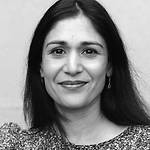
Special Issue
CRASE
Bright Future or Cautionary Tale? How the Bay Area Shapes the Future of the U.S.
California is the Home of the Multiracial Movement

The future is mixed. Since 2000, when people were granted the opportunity to indicate more than one ethnicity on the U.S. Census Bureau survey, we have not only seen an increase in the multiracial population, but we have also grown to understand that identity is not simply a matter of checking off boxes. With estimates ranging from 2.6% to 7%, there is little dispute that the fastest growing population in the U.S. is mixed. In fact, it is growing at three times the rate of the general population. California is home to the largest multiracial population in America. Yet, 61% of adults who could technically identify as mixed, do not. Social movements within California, in particular Southern California, are increasingly advocating for multiracial people’s right to self-identify as mixed and this new identity group will have implications for how we conceptualize race in America.
According to the 2015 Pew survey, variations in identifying as multiracial vs. monoracial depends on a number of factors. For example, there are between-group differences such that those who have an Asian-White background are more likely to identify as multiracial whereas people with Black-White and Native American-White are more likely to identify as monoracial. The Latina/o-White and other multiracial pairings are harder to measure because of different notions of race, ethnicity and culture. Phenotype, how a person appears to others, is one of the largest determinants of whether or not people identify as monoracial or multiracial.
Recent studies in psychology revealed that the extent to which one’s minority ethnicity is seen as socially threatening or intimidating also determines whether people perceive someone who is mixed as monoracial or multiracial. Mixed people identified as having African American or Arab ethnicity were more likely to be associated with only their minority group than multiracial others deemed as less threatening. Therefore, how mixed race people appear to others has long been a major determinant in how they categorize themselves.
What about how the group members themselves feel? How do they self-identify? When asked, many people in this group describe how their racial identity has changed over time and situation. They talk about feeling as if they belong to multiple categories and want to be accepted by their multiple groups. Understanding the need to recognize the unique dilemmas mixed race people face, psychologist Maria Root created a bill of rights for people of mixed heritage. It is an unapologetic recognition of their right to complexity, fluidity, dignity, and respect.
California is at the forefront of the mixed race right to self-identification and acceptance. There is growing recognition that there is a call to be seen as more than the sum of their parts by people of mixed heritage. The longest running college course on multiracial identity is taught by Professor Reginald Daniel at UCSB. Recently, Mixed Heritage Day was created by two mothers who develop community events in support of multiracial kids in Los Angeles. A non-profit in Southern California, Mixed Remixed is a film, book, and performance festival.
Determining and identifying who is multiracial or not has political history. Understanding the common challenges and strengths amongst the group as a whole and also why certain multiracial groups experience more discrimination than others is necessary for this group to support each other in their right to self-identify. Although the Bay Area is home to some of state’s most multiracial counties, it is behind Southern California’s grassroots efforts to support this population. The Bay Area has an impressive track record in fighting for inclusivity and acceptance. Ideally, it will partner with their neighbors to create sweeping change.
 Saera Khan is Professor of Psychology at the University of San Francisco College of Arts and Sciences. Her writing focuses on how people rely on stereotypes and biases to form judgments about others and people's sense of belonging when they are from marginalized groups. Her essay, "Confronting Complex Multiracial Realities" appeared in Psychology Today online.
Saera Khan is Professor of Psychology at the University of San Francisco College of Arts and Sciences. Her writing focuses on how people rely on stereotypes and biases to form judgments about others and people's sense of belonging when they are from marginalized groups. Her essay, "Confronting Complex Multiracial Realities" appeared in Psychology Today online.